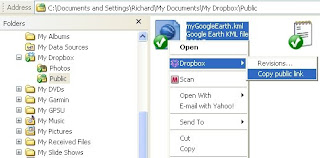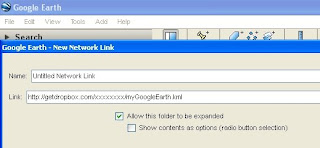For those of you who prefer FireFox over Internet Explorer (and who doesn't), I recently came across a pretty cool extension called Minimap. While it has much of the same functionality of Google Maps, it's nice because it's built right into your browser. You can open the map as a separate tab, or as a sidebar.
It also supports a number of file importing and exporting formats, including GPX and KML, which is great for viewing geocaching waypoint and GPS data. While adding KML data to the map (either by importing or drag and drop) seems to work great, I have yet to successfully import a GPX file - and I've tried everything from pocket queries to my latest GPS track data file. But since this is a fairly new program (18 months old), I expect the program developers will have this feature fixed eventually.
The mapping tool also integrates nicely with other "geo-aware" web services such as Flickr, Panoramia, Local search, Google, Yahoo!, Live Local directions, Tagzania, Platial, Geourl and many more.
You can download and install this free program from the Firefox Add-On page.
Check out this short video which describes some of the key features and browser set-up:
While I've only used this add-on for a short time, I already love it. And once I can get the GPX import feature to work properly, it'll likely become part of my standard geocaching software toolbox.
Cache On!
January 24, 2009
January 18, 2009
This Week In The Caching World
Following is a smattering of some of the more interesting, and entertaining, cache-related web sites and blog posts I came across this past week:
Ever wonder how you rank in comparison with your fellow cachers in your home state? Well, now you can find out at Cacherstats.com. Here you'll find a ranked listing (by state, or province, or country) of every cacher with more than 200 finds.
Headhardhat provides this very helpful tutorial on how to create, and post, your geocaching stats into your geocaching.com profile. Thanks HHH.
You've got to have a good sense of humor when you live and cache in the mid-west; and the Northwoods GeoCats do!
And finally, I leave you with this find by EMC of Northridge. In this post, she provides a link to a home-made video created by some creative cachers down under. A new twist on an old classic; but good luck getting this song out of your head afterward. Crikey!
Happy Caching!
Ever wonder how you rank in comparison with your fellow cachers in your home state? Well, now you can find out at Cacherstats.com. Here you'll find a ranked listing (by state, or province, or country) of every cacher with more than 200 finds.
Headhardhat provides this very helpful tutorial on how to create, and post, your geocaching stats into your geocaching.com profile. Thanks HHH.
You've got to have a good sense of humor when you live and cache in the mid-west; and the Northwoods GeoCats do!
And finally, I leave you with this find by EMC of Northridge. In this post, she provides a link to a home-made video created by some creative cachers down under. A new twist on an old classic; but good luck getting this song out of your head afterward. Crikey!
Happy Caching!
January 10, 2009
Geocaching In The Cloud
Lately I've been playing around with a cool little application called, Dropbox. It provides a very simple and convenient way to store, share and access your files across multiple platforms. Any files or folders inside your personal Dropbox folder will get synchronized to Dropbox's servers, and to any other computer linked to your account. Thus, you basically have access to the files you store in your Dropbox folder from any computer with an internet connection.
What I really like about Dropbox, however, is a feature that can give files a unique URL address, or internet link. This allows you to send files to other people in e-mails, IMs, blogs, etc. without requiring those people to sign up for Dropbox. This is also a great way to host Google Earth KML and KMZ files, including network links. In other words, if you keep and update KML files in a designated Dropbox folder on your computer at home, these files will automatically update on the web in a fully scalable fashion.
So for example, if you frequently generate Google Earth KML files from your geocaching.com pocket queries (using either GSAK, GPSvisualizer, or another tool), you can then store those KML files in your public Dropbox folder so that the most recent version of the file will load every time you launch Google Earth; no matter where you launch Google Earth from.
To set this up, all you have to do is right-click on the KML file once it's in your public Dropbox folder, and select"Copy public link" under the Dropbox menu:

Then open Google Earth, go to "Add", then "Network Link", and paste the link you just copied into the Link box:

That's it. From this point on, as long as you continue to replace old KML files with new versions, you'll have instant access to your latest geocaching KML data every time you launch Google Earth; from anywhere!
For more information about Dropbox, take a look at this tour; or, to see Dropbox in action, check out this video. Note that Dropbox is still in beta, so use at your own risk. Even so, I've been using it for a while now, and never had a single problem (and I'm good at breaking things).
Enjoy, and Cache On!
What I really like about Dropbox, however, is a feature that can give files a unique URL address, or internet link. This allows you to send files to other people in e-mails, IMs, blogs, etc. without requiring those people to sign up for Dropbox. This is also a great way to host Google Earth KML and KMZ files, including network links. In other words, if you keep and update KML files in a designated Dropbox folder on your computer at home, these files will automatically update on the web in a fully scalable fashion.
So for example, if you frequently generate Google Earth KML files from your geocaching.com pocket queries (using either GSAK, GPSvisualizer, or another tool), you can then store those KML files in your public Dropbox folder so that the most recent version of the file will load every time you launch Google Earth; no matter where you launch Google Earth from.
To set this up, all you have to do is right-click on the KML file once it's in your public Dropbox folder, and select"Copy public link" under the Dropbox menu:

Then open Google Earth, go to "Add", then "Network Link", and paste the link you just copied into the Link box:

That's it. From this point on, as long as you continue to replace old KML files with new versions, you'll have instant access to your latest geocaching KML data every time you launch Google Earth; from anywhere!
For more information about Dropbox, take a look at this tour; or, to see Dropbox in action, check out this video. Note that Dropbox is still in beta, so use at your own risk. Even so, I've been using it for a while now, and never had a single problem (and I'm good at breaking things).
Enjoy, and Cache On!
January 3, 2009
New Year's Cacholutions
Okay, Okay, I know geocaching is not about the numbers, it's about the location. But let's face it, when a new year rolls around, it's hard not to look back on lasts year's find statistics in order to set goals for the coming year.
For example, let's say you found 250 caches in 2008 (well done if you did). Is it so wrong to resolve to get 365 finds in 2009 (which equates to one find per day)? After all, that just means you'll be spending less time in front of the TV and computer, and more time outdoors getting exercise - and there's nothing wrong with that!
Looking back on 2008, I'm happy to report that I did achieve a couple of the geocaching goals I had set for myself, including:
Thanks, and happy caching in 2009!
For example, let's say you found 250 caches in 2008 (well done if you did). Is it so wrong to resolve to get 365 finds in 2009 (which equates to one find per day)? After all, that just means you'll be spending less time in front of the TV and computer, and more time outdoors getting exercise - and there's nothing wrong with that!
Looking back on 2008, I'm happy to report that I did achieve a couple of the geocaching goals I had set for myself, including:
- Average at least one find per day. I ended up averaging 1.3 finds per day in '08.
- Beat my previous personal best of 49 finds in one month. I did this on three separate occasions.
- Complete my first challenge cache. I found the Bay Area Quadrangle Challenge on December28th.
- Practice CITO at every opportunity.
- Increase my cache hides-to-finds ratio.
- Learn how to use UTM coordinates (All the expert navigators tell me it's way better than the lat/long system).
- Don't copy and paste my cache logs. Give each log it's deserved individual flavor.
- Do more challenge caches.
- Find 500 caches in '09 (beating my previous 2008 record of 457 finds).
- Go after more 5-star caches.
- Get better at solving puzzle caches.
- And finally, don't get hurt (easier said than done sometimes).
Thanks, and happy caching in 2009!
Subscribe to:
Comments (Atom)